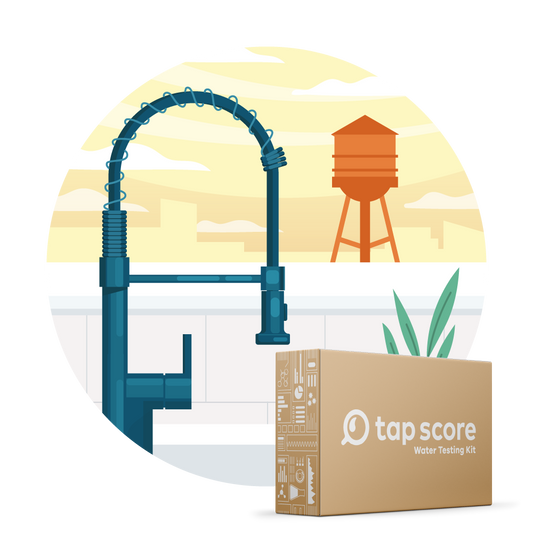
How Do You Pick the Best Water Filter for Your Home in 2025?
What’s the best way to choose a water filtration system for your home? Researching the best water filter is more difficult than it ought to be. Because water quality content is often written by filtration companies, getting the unbiased information and advice you need can be confusing.
We wrote this ultimate guide to help you feel empowered when deciding which water filtration technology to invest in. In fact, after reading this guide, you might discover you don’t even need a filter at all.
Table of Contents:
- What’s Actually in Your Water?
- What Treatment Technology Is Right for You?
- The Importance of Certification for Water Filters
- Doing it Right: Top Tips for Filter Life
- What’s the Best Water Filter for You?
- What’s the Takeaway?
Disclaimer: This guide is free of affiliate links. We do not earn commissions, in fact we do not link to treatment products at all. Rather, our goal is to simplify the process of understanding household water quality—from testing to treatment.
What’s Actually in Your Water?
The first—and most important—part of picking a good water filter is evaluating what is present in your water that you need to filter out. In order to do that, you’ll want access to in-depth water analysis.

How? There are a couple reliable routes available:
Public Water Quality Data
The Federal Environmental Protection Agency (EPA) regulates the drinking water provided by public water systems through the Safe Drinking Water Act. The EPA’s main list of contaminants that pose health risks in tap water includes more than 100 contaminants.[1] Some of the most common drinking water contaminants include:
-
- Lead
- Arsenic
- PFAS
- Iron
- Uranium
- Disinfection byproducts (city, or chlorine disinfected water)
- Nitrates (private well water)
- Coliform Bacteria (private well water)
Publicly available water quality data exists through a variety of databases. One major shortcoming, though, is that the vast majority of public water data is only reflective of water samples collected at the water treatment plant. That means the data is not indicative of the water quality flowing through your household tap because it hasn’t yet passed through the local distribution system or your home’s plumbing.
These samples are usually collected annually. For general information on last year’s water quality in your area, take a look at:
Mail-to-Laboratory Water Tests
To get the most detailed picture of your water quality, you’ll want to invest in a home water test kit.
Drinking water test kits that rely on a laboratory for analysis are more expensive. But while they carry increased up-front costs, the robust body of information they provide can often help save you money down the line.
Lab Tests or Test Strips: What's the Best Water Test?
For example, if you don’t test your water before buying a filtration system, you could be wasting your money by buying a treatment system that isn’t tailored to your specific water quality.
Customers of public water utilities (or those on “city water” as it’s often called) will benefit from this home water analysis kit. The Advanced City Water Test kit provides everything you need to properly collect and submit a water sample for certified laboratory testing. You’ll receive results in the form of detailed, easy-to-read, analyses of common water chemistry parameters and health concerns, like water hardness and pH, as well as heavy metals, volatile organic compounds, and frequently detected disinfection byproducts from the addition of chlorine and chloramine.
Tap Score also offers home water testing kits for private well owners that are specialized to address contaminants such as hardness, silica, heavy metals, minerals, and nitrates and coliform bacteria, which are important to test for annually. Additionally, the advanced kit tests for volatile organic compounds related to human/industrial activity (treatment, industrial waste, agriculture, and more) which can impact private well supplies.
If you’ve never tested your private well before, we recommend the most comprehensive water test kit for well water, the Extended Well Test, which includes additional risk factors including radioactive particles, radon, tannins, bacteria, plasticizers and pesticides.
What About Drinking Water Test Strips?
DIY water test strips for homes are inadequate for comprehensive water quality testing. They can be useful for simple parameters like chlorine levels and pH, but for contaminants of interest worth filtering out, you want the kind of water analysis only a laboratory can provide. Yes, they are cheap and easy. But, unfortunately, they fail to accurately detect practically everything that matters to making the right decision—contaminants like lead, arsenic, DBPs, VOCs, and PFAS. All the equipment and expertise of a lab exists for good reason.
Where Can I Get My Water Tested for Free?
Some water utilities offer laboratory water testing for free. However, they are usually tailored to a handful of local contaminants, sometimes only one in particular. Do not accept a free water test from a filtration company. Those are usually sure-fire ways to get strong-armed into investing in the treatment system they want you to invest in, and not one meant for your specific needs.
What Treatment Technology Is Right for You?
Different contaminants require different treatment technologies; no single technology can fully remove everything (despite what companies may claim on their websites). The first step in determining the best treatment technology for your situation is a comprehensive water quality test.
With a water quality report from a laboratory you can then determine the best filtration technology(s) for your specific contaminant profile.
Results provided through Tap Score’s water analysis kits include a full list of contaminants detected in your water, as well as benchmarks to help make sense of the concentrations of the contaminants.
We also make unbiased treatment recommendations. Understanding how each treatment system may impact your water is integral to being satisfied with your setup. Knowing what you want and what you don’t want (a filter that requires frequent maintenance, for example) will help with your selection process.
Water Treatment Technologies
There is a large variety of treatment technologies used in filters for household use. It’s important to choose the right one to address your home’s water quality issues. Here is a list of some common technologies for home and apartment water treatment:
-
- Activated Carbon
- Reverse Osmosis
- Anion Exchange
- Cation Exchange (aka Water Softener)
- UV disinfection
- Chlorination
- Oxidation and Filtration
- Aeration
- Distillation
On the whole, however, most household water treatment technologies can be grouped into four major categories:
-
- Membrane filtration
- Adsorption
- Ion exchange
- Disinfection
We’ve covered them in detail in the Top 4 Water Filtration Technologies for Homes.
- Membrane filters: The contaminants that they effectively remove depends on the size of their pores. Pore sizes range from 0.1 micron to 0.0001 micron. Removal of dissolved minerals like calcium and magnesium requires the smallest pores (down to 0.0001 micron) while removal of larger microplastics (up to 5 microns) is possible with the much larger pores.
- Adsorption: Adsorptive media filters—particularly activated carbon—are highly versatile and used in common point-of-use devices like pitcher filters. Contaminants stick to the filter media as water flows through the filters. They are designed to capture a wide range of pollutants depending on the filter media, including heavy metals, organic compounds, and aesthetic impurities.
- Ion exchange: Typically point-of-entry systems, these filters contain beads made of a resin that have ions attached to their surface. As contaminated water passes by the resin, the ions on these beads are exchanged for unwanted ions in the water. Water softeners are a type of cation exchange, specifically exchanging hardness-causing ions like calcium and magnesium for sodium or potassium ions.
- Disinfection: Disinfection technologies only address microbial risks and should be considered only when bacteria and other microorganisms have been detected. Common disinfection technologies include UV disinfection and chlorine.
Personal Preferences: What Matters Most?
Choosing the right product also requires thinking about your personal needs and requirements. Do you live in a small apartment or do you have a giant garage? Do you need to treat ALL of your water or just the drinking water? Choosing the right installation location is really important. Water treatment devices are divided into two types:
- Point-of-Entry (POE)
- Point-of-Use (POU)
For example, because lead was commonly used in household plumbing networks, a point-of-entry system that filters your water before it passes through your pipes opens it up to re-contamination. In this case, you’d want a point-of-use solution (i.e., a counter-top, under-sink, or pitcher unit).
Whether you rent or own your home makes a big difference as well. Additionally, municipal tap water and well water can contain different types of contaminants. The following guides can help you understand the intricacies of each:
Renters Guide to Water Testing and Filtration
Best Water Test Kits for New Homeowners
Ultimate Guide to Well Water Contaminants
You can also read unbiased reviews about some of the most popular home water filtration brands:
The Importance of Certification for Water Filters
Once you have the information you need to purchase the right water filtration system, you should look for a brand with products that have been certified to specifically designed treatment standards.
You want to know that the filter you purchase is effective and reliable at removing the contaminants that matter to you. That’s where certifications come in. In the absence of any federal regulation of treatment devices, specific third-party organizations help provide consumers with unbiased information about which products will be effective for their water treatment needs by certifying products to specifically designed treatment standards (i.e., NSF/ANSI standards).
Without certifications like these, the only information we have about a product’s effectiveness comes from the company selling the product. While it is likely that much of this information is accurate, there are no guarantees. Third-party testing is helpful to sort through the noise.
The three main organizations that certify water treatment devices are:
- Water Quality Association (WQA)
- National Sanitation Foundation (NSF)
- International Association of Plumbing and Mechanical Officials (IAPMO)
While certifications aren’t mandatory, even if a product works as promised, they are a helpful guidepost. Additionally, there’s no way to know a company’s intentions behind not getting certification. Some filtration companies opt to skip certifications while making a product that is effective and would pass certification tests. But the lack of certification could very well mean that the product is inferior and would have been unlikely to meet certification standards.

We recommend taking the extra time and looking into products that have proper certification when choosing a product for your home.
NSF/ANSI Certifications Explained
If you need help picking between brands and products with the right certifications, you can contact us. Or check out some of these guides to certified water filters by contaminant to help your decision-making process:
Quick Guide to Faucet Filters
Quick Guide to Certified Water Filters for PFAS
Quick Guide to Certified Water Filters for Lead (Pb)
Quick Guide to Certified Water Filters for Fluoride
Top Tips Once You’ve Selected a Water Filter
-
Certified professional installation
If you purchase a product that requires complex installation, be sure to get professional help. This is particularly true for point-of-entry filtration systems. These are often larger, more expensive systems and require more expertise with plumbing
The Water Quality Association keeps a robust record of certified water filtration installation personnel across the USA. Consult the WQA Find a Member directory and be sure your product is properly installed. IAPMO maintains a similar directory, but be aware that it extends beyond water filtration.
-
Follow the instructions
No engineered product works properly unless the instructions are followed. The instructions will specify things like proper upkeep, recommended breaking-in period, proper flow rates, etc.
-
Maintenance and upkeep
Every filtration technology has different pros and cons when it comes to maintenance. Be sure to follow those recommendations carefully. If you live in a large household with high water use, your filter’s lifespan will be shorter than if your water use was lower. Keep track of the months between filter changes. The leading cause of filter failure is people forgetting to change the filter on time.
Pay attention to what kind of water goes into your filter: some POU filters can be compromised by hot water; some POE filters can be compromised without adequate pre-filtration.
-
Performance testing
How do you know if your filter is working properly? You can performance test it. Simply put, a performance test is a water test of your filtered water. In order to accurately gauge the filter’s performance, however, you want to know the quality of your water before the filter was installed. That’s easy if you tested your water before purchase. Once you test your filtered water, you can compare those results to your initial test to see how effective your new filter is at reducing your contaminants of concern. But remember, you’ll want to test only after the filter’s breaking-in period.
Each system requires its own “break-in” period, or a volume of water required to flush the filter before routine use begins. Why? Because this delay allows the new equipment to adjust to your plumbing and your daily patterns of water use. It also helps flush out the materials used in the manufacturing of your filter system—like polymers, metals, volatile organic compounds (VOCs), etc.
So What's the Best Water Filter for You?
The best water filter for you depends on your specific water quality needs and your personal preferences. Different treatment technologies are effective for different contaminants, and they all have their own pros and cons.
- For more common concerns like the taste or smell of chlorine in your water, pitcher filters can be very helpful. Some even sell advanced filters for contaminants like lead and PFAS. Be sure to look for certification!
- For more advanced concerns like heavy metals, PFAS, or disinfection byproducts (DBPs, like trihalomethanes and haloacetic acids), you might want a more advanced undersink system—e.g. reverse osmosis, ion exchange
- Lastly, if you want to invest fully in your home’s water treatment, you can consider a whole-home water filtration system. These will filter all the water in your home and require professional installation
Because there’s really no one-size-fits-all answer, a little pre-emptive investigation through water testing goes a long way!
It’s worth noting that while there are other, more obscure filtration and treatment systems that we didn’t cover, more often than not the conventional technologies will address your issues.
What’s the Takeaway?
- Having your water tested by a lab will cost more up front than some other popular options. But lab testing is the bare minimum for reliable and case-specific information about your water.
- The best water filtration system is the one that best addresses your home’s water quality and your personal preferences.
- Proper installation and maintenance is the only way to safeguard your treatment device’s longevity and effectiveness.
Read More
▾Heavy Metals Everyone Should Test For
Why Is Uranium In Drinking Water?
Your Water's General Chemistry
The Ultimate Guide to PFAS
7 Pathogens That Contaminate Drinking Water
What Is a Consumer Confidence Report (CCR)?
Top 4 Most Popular Water Filtration Technologies For Homes
NSF Certifications Explained
POE Versus POU Water Treatment









